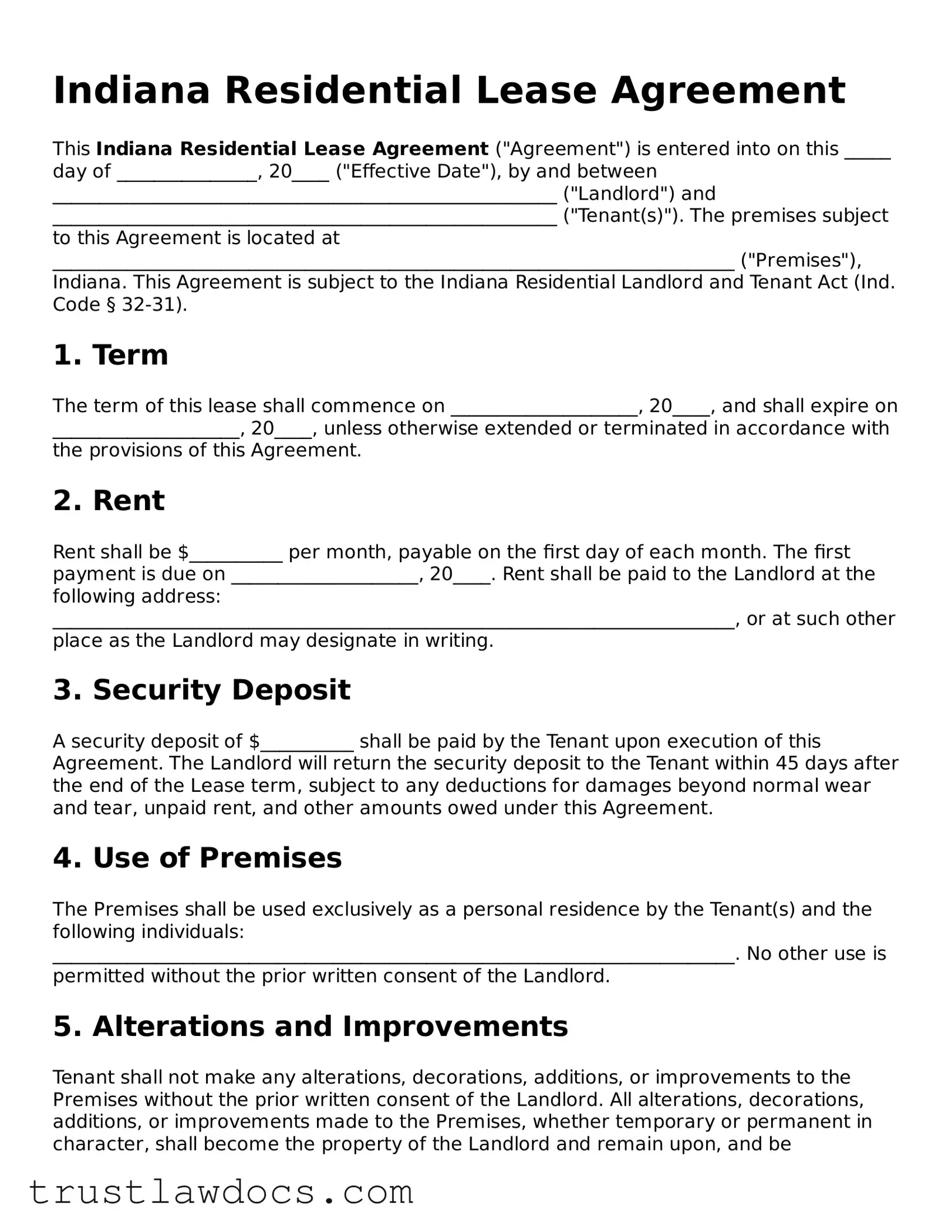Indiana Residential Lease Agreement
This Indiana Residential Lease Agreement ("Agreement") is entered into on this _____ day of _______________, 20____ ("Effective Date"), by and between ______________________________________________________ ("Landlord") and ______________________________________________________ ("Tenant(s)"). The premises subject to this Agreement is located at _________________________________________________________________________ ("Premises"), Indiana. This Agreement is subject to the Indiana Residential Landlord and Tenant Act (Ind. Code § 32-31).
1. Term
The term of this lease shall commence on ____________________, 20____, and shall expire on ____________________, 20____, unless otherwise extended or terminated in accordance with the provisions of this Agreement.
2. Rent
Rent shall be $__________ per month, payable on the first day of each month. The first payment is due on ____________________, 20____. Rent shall be paid to the Landlord at the following address: _________________________________________________________________________, or at such other place as the Landlord may designate in writing.
3. Security Deposit
A security deposit of $__________ shall be paid by the Tenant upon execution of this Agreement. The Landlord will return the security deposit to the Tenant within 45 days after the end of the Lease term, subject to any deductions for damages beyond normal wear and tear, unpaid rent, and other amounts owed under this Agreement.
4. Use of Premises
The Premises shall be used exclusively as a personal residence by the Tenant(s) and the following individuals: _________________________________________________________________________. No other use is permitted without the prior written consent of the Landlord.
5. Alterations and Improvements
Tenant shall not make any alterations, decorations, additions, or improvements to the Premises without the prior written consent of the Landlord. All alterations, decorations, additions, or improvements made to the Premises, whether temporary or permanent in character, shall become the property of the Landlord and remain upon, and be surrendered with the Premises at the end of the term hereof, except as otherwise provided by law or agreed in writing.
6. Maintenance and Repairs
The Tenant agrees to keep the Premises in a clean, safe, and sanitary condition, and to promptly notify the Landlord of any repairs that are needed. The Landlord is responsible for maintaining the Premises in a habitable condition, in compliance with all applicable codes, regulations, and ordinances.
7. Default
If the Tenant fails to comply with any of the terms of this Agreement, the Landlord may terminate this Agreement upon providing the Tenant with written notice, as required by Indiana law. Upon termination, the Tenant shall vacate the Premises immediately and forfeit any security deposit, as permitted by law.
8. Governing Law
This Agreement shall be governed by and construed in accordance with the laws of the State of Indiana.
9. Entire Agreement
This Agreement contains the entire understanding between the parties and supersedes all prior agreements, understandings, negotiations, or representations, whether oral or written. This Agreement may only be amended in writing, signed by both parties.
Signatures
IN WITNESS WHEREOF, the parties hereto have executed this Indiana Residential Lease Agreement as of the Effective Date first above written.
Landlord: ___________________________________________ Date: _______________
Tenant(s): __________________________________________ Date: _______________
